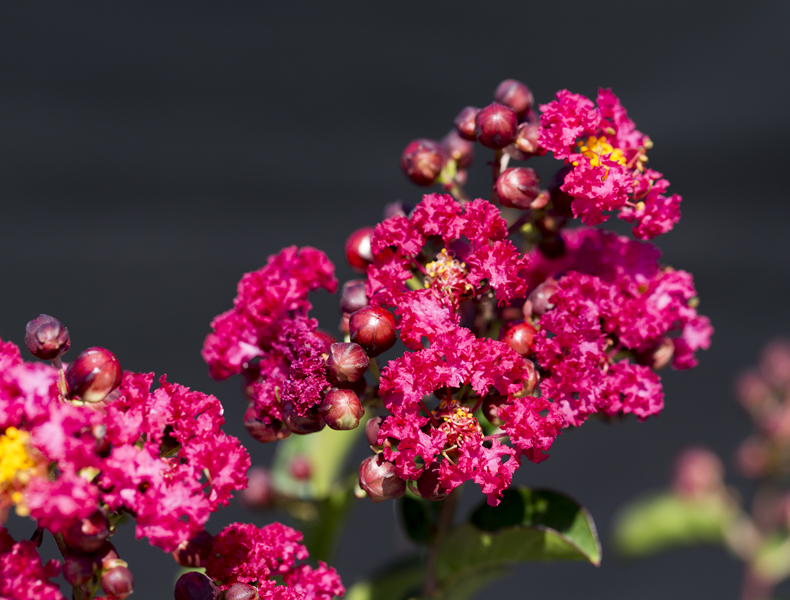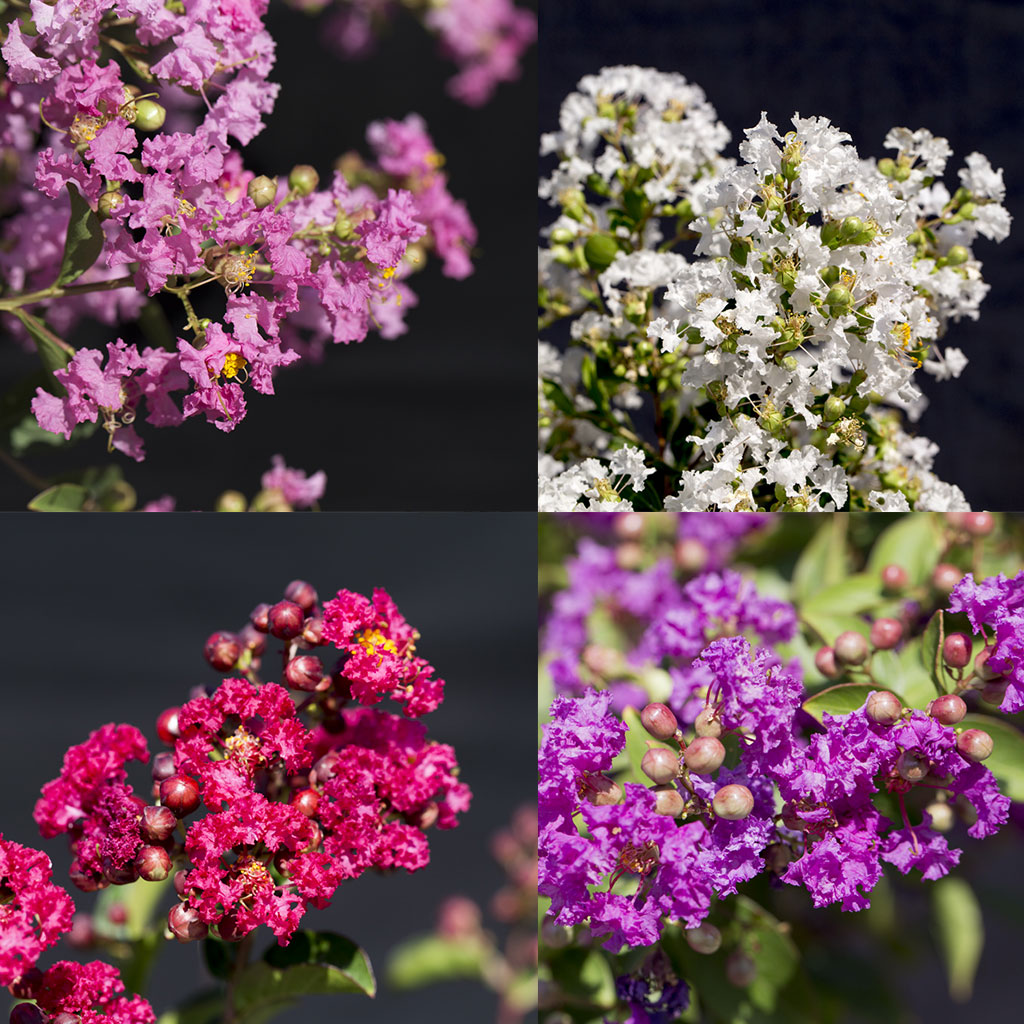Nursery Ciarrocchi Lagerstroemia

Lagerstroemia are among the most satisfactory of plants: showy summer flowers, attractive bark, and (in many cases) brilliant fall color make them year-round garden performers. Long, cool autumns yield the best leaf display.
Most Lagerstroemia in gardens are selections of Lagerstroemia indica or hybrids of that species with L. fauriei. The latter species has attracted much notice for its hardiness and exceptionally showy bark.

The incredible colours of Lagerstroemia plants
Lagerstroemia care
All Lagerstroemias bloom on new wood and should be pruned in winter or early spring. On large shrubs and trees, remove basal suckers, twiggy growth, crossing branches, and branches growing toward the center of the plant. Also gradually remove side branches up to a height of1-2 meters; this exposes the handsome bark of the trunks. During the growing season, clip off spent flowers to promote a second, lighter bloom. Also prune dwarf forms periodically throughout the growing season, removing spent blossoms and thinning out small, twiggy growth.
By following a few simple steps you will be able to grow beautiful Lagerstroemia and enjoy amazing blooms all summer long. You can just repot in a bigger container, Lagerstroemia grow very well in containers. Or you can plant them in the garden.
1. Select the site where you wish to plant your new Lagerstroemia. Crape Myrtles can be grown all over Europe, in any soil type. The site should be in the bright, hot sun: full or partial sun (6hrs min). No heavy shade for Lagerstroemia. If the site gets sun for part of the day then it’s fine. But they do best in full, hot sun. Remember: the more sun, the more blooms.
2. Dig a hole the size of 3-4 liters and replace the soil with any potting mix containing Peat Moss, Perlite, Vermiculite and finely ground pine bark. Heavy sand based mixes, are not recommend as they hold too much moisture.
3. Plant your new Lagerstroemia. Make a hole in the center of the potting soil mix with your fist, pushing down into the soil. It’s OK if you place the plant “deep.” Sometimes, especially with the vertical varieties, you have to plant them deep so they will stand up straight. Firmly pack soil around the stem. Water the plant thoroughly after planting. After watering you may have to add a little more potting soil around the plant and tap soil down.
4. Add Mulch. Put a good bit of mulch around the plant. It’s fine if it touches the stem of the plant. This will help retain moisture and heat during the coldest winter months. Pine Bark or Cypress mulch is best. This is especially recommended for Customers in colder zones. Put mulch at least 5 cm. thick.
Note – If you plant your Lagerstroemia in the garden in Fall or Winter, when the leaves are falling or are already dormant, only water 2 or 3 times until spring. Don’t over water! Over watering in the Fall and Winter makes the plants more susceptible to winter damage. In Spring and Summer water weekly especially if the weather is dry. Don’t begin fertilizing until Spring.
By following these four simple steps you will be well on your way to growing amazingly beautiful Lagerstroemias. Be prepared for fast growth and numerous blooms!
Lagerstroemia Indica
Lagerstroemia indica, the premier summer-flowering shrub tolerates heat, humidity, drought; does well in most soils as long as they are well drained. May be frozen to the ground in severe winters, but will resprout. For colder regions are available cold-hardy selections such as ‘Acoma’, ‘Centennial Spirit’, and ‘Hopi’. Variable in size (some forms are dwarf shrubs, others large shrubs or small trees) and habit (spreading or upright). Dark or green leaves are 2-6 cm long and somewhat narrower, usually tinted red when new; they often turn brilliant orange or red in fall. Crinkled, crepe-papery,2-4 cm wide flowers in white or shades of pink, red, or purple are carried in dense clusters.
Trained as a tree, it develops an attractive trunk and branch pattern. Smooth gray or light brown bark peels off to reveal smooth, pinkish inner bark; winter trunk and branches seem polished.
Mildew can be a problem, but most of Lagerstroemia indica hybrids are mildew-resistant.
Lagerstroemia Pruning Tips
When pruning a Lagerstroemia, don’t chop your plant down to ugly stubs each spring just because your neighbors do. This ruins the natural form and encourages the growth of spindly, whiplike branches that are too weak to hold up the flowers. To reduce a crepe myrtle’s height, use hand pruners or loppers to shorten the topmost branches in late winter, always cutting back to a side branch or bud. For bigger branches, always cut back to the crotch or trunk. Don’t leave big, ugly stubs.
Lagerstroemias are a very resilient plant, so there’s really no “wrong” way to prune them. The answer all depends on what you would like your end result to be.
Lagerstroemias only bloom on new growth. The more old wood you remove, the more new growth the plant will have to produce. This new growth is where all the blooms will appear. Lagerstroemias should be pruned in the winter months when they are dormant.
Properly pruning you Lagerstroemia will maximize blooms, promote new growth and give your plant a great shape. Pruning is done in winter when the plant is dormant, between the months of December and February. Aggressive pruning is not necessary to achieve a beautiful, healthy plant.
“Suckers” refers to the new growth that comes from the base of the trunk. Most people prune these off. However, if you want your Crape Myrtle to have a more “natural” look or would like it to have multiple trunks, leave some of the suckers to grow. Blooms will appear on new growth suckers.
Lagerstroemias have been traditionally grown as “Single-Trunk” or “Multi-Trunk”, but allowing them to grow into it’s natural shape has been the trend in recent years. This approach requires little to no pruning. Just allow your plant to branch and spread naturally. Your Lagerstroemias will still bloom and be beautiful if watered often and properly fertilized.
It is necessary to remove any dead flowers and seed pods if you wish to extend your Lagerstroemia’s blooming season. Cut off the old flowers, flower clusters, and round seed pods in July, August and September and if you keep fertilizing the plants, they will keep vigorously producing blooms until the first frost.
How to fertilize a Lagerstroemia
Everyone wants to get the most blooms from their Lagerstroemias. One rule of thumb to always remember, Lagerstroemias only bloom on new growth!So more new growth equals more blooms.
We recommend multi-purpose liquid fertilizers. Using these types of fertilizers will cover your bases if the soil in your area is deficient in a certain element or trace mineral. Any variety of 10-10-10 or 20-20-20 Fertilizer with trace minerals will do just fine, and is available at most stores. If you do not wish to take the time to fertilize often, you can choose a slow-release fertilizer, such as Osmocote. These are only our general recommendations. You may use the fertilizer of your choice. You know your soil best. Just follow the instructions on the provided with your fertilizer of choice. When choosing a fertilizer for your Lagerstroemias, keep in mind that they are heavy feeders and are more prosperous when fed often.
Begin fertilizing in Spring with the fertilizer of your choice (liquid, slow release or granules), when the first leaves start to appear. Established, well rooted, Lagerstroemias are heavy feeders. Lightly fertilize every two weeks throughout the spring and summer months. This will promote optimal new growth. Remember, Lagerstroemias only bloom on new growth. Always water your Lagerstroemia after applying your fertilizer. Then water once a week, or more often if you live in a dry, arid climate.
Discontinue your fertilizing routine in later fall and begin watering less often. This will help the plants “harden off.” Hardening off is a process which better prepares the plant for winter dormancy. It essentially toughens up the plant so it may withstand the drier, colder conditions of winter. It’s during this winter dormancy that you’ll want to prune your Lagerstroemia if you so desire.
These are the simple Secrets for growing Lagerstroemias that bloom for 5 or even 6 months per year. Remember Lagerstroemias are different from any other woody perennial in that they bloom on NEW GROWTH MADE IN SPRING AND SUMMER. The more new growth you can create by planting them in a good potting soil and fertilizing weekly, the more flowers you will have to enjoy!
Disease Control
This line of Lagerstroemias have been bred to be Cold Hardy and Disease Resistant. However, like all plants, Lagerstroemias can experience an occasional insect or mildew problems. The most common is Mildew. Mildew is a fungus.
The white powder that comes from the leaves of an affected Crape Myrtle are the spores mildew releases in order to reproduce. Mildew thrives in warm, moist conditions. To remedy this situation, you will need to apply fungicide. You may use a generic fungicide that contains propiconazole, tebuconazole, thiophanate-methyl, myclobutanil or triadimefon. Follow the instructions included with your fungicide of choice. Keep treating until the mildew has retreated.
You must never listen to flowers. Just look at them and smell them
- Antoine de Saint-Exupéry

 English
English Italiano
Italiano  Deutsch
Deutsch  Français
Français 

